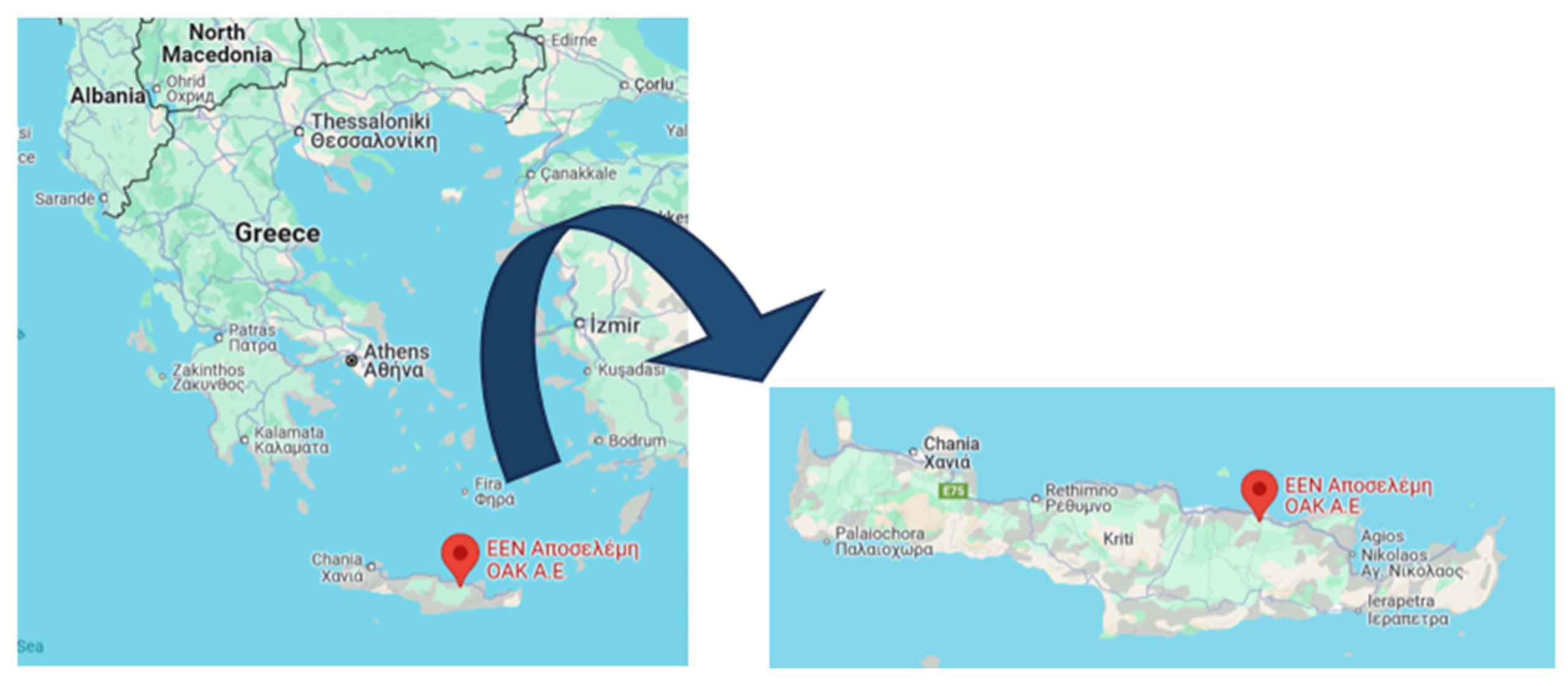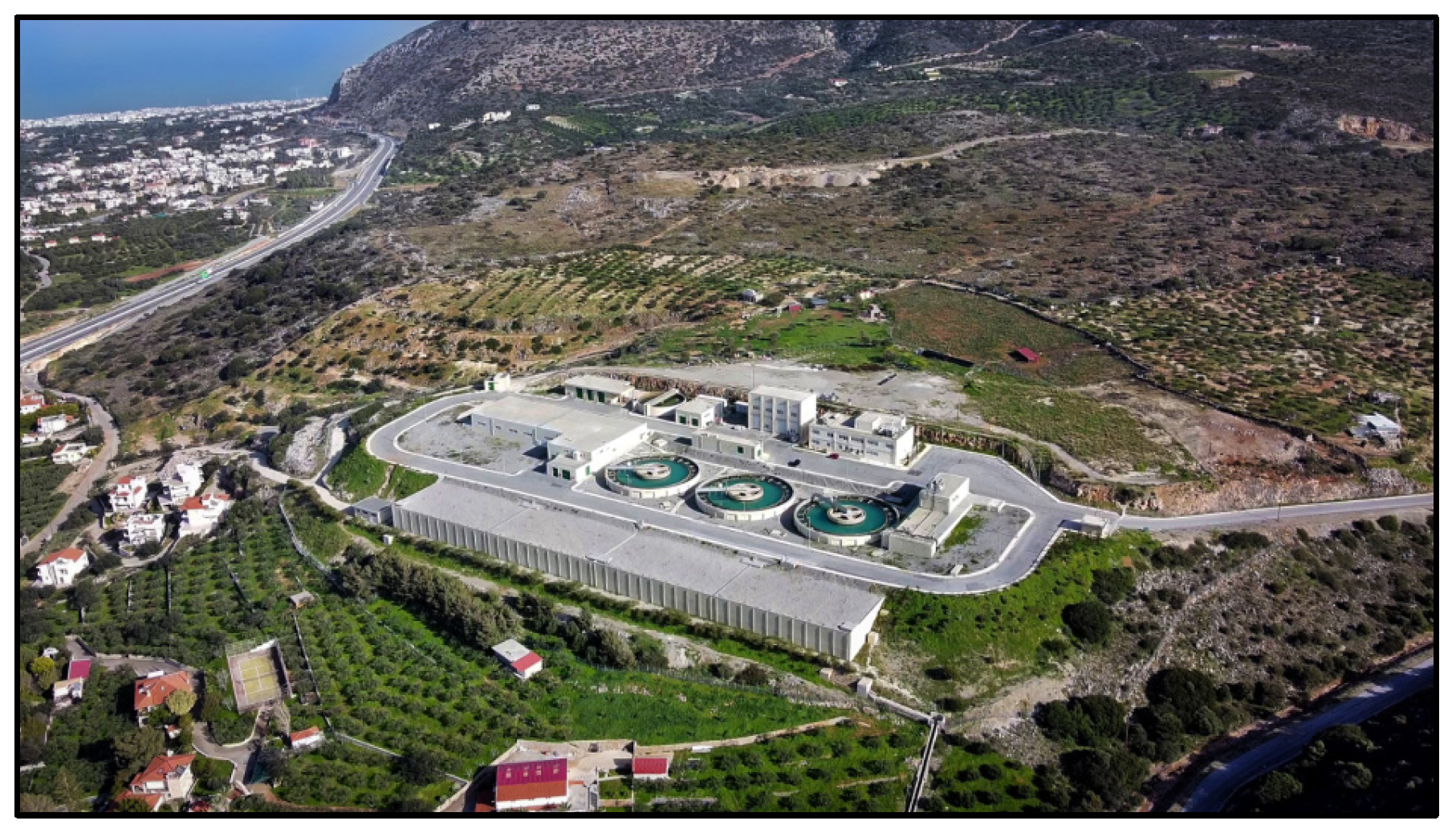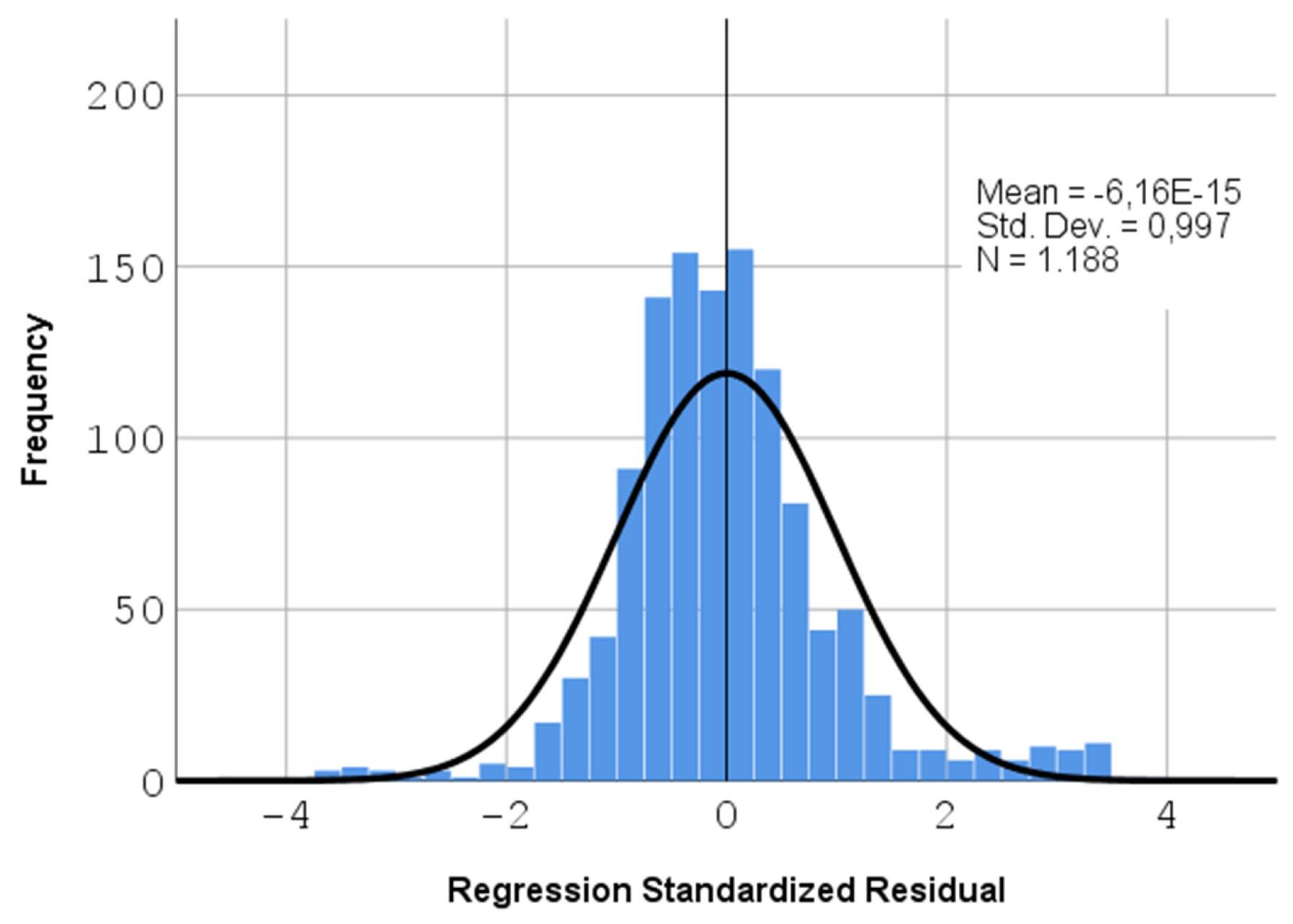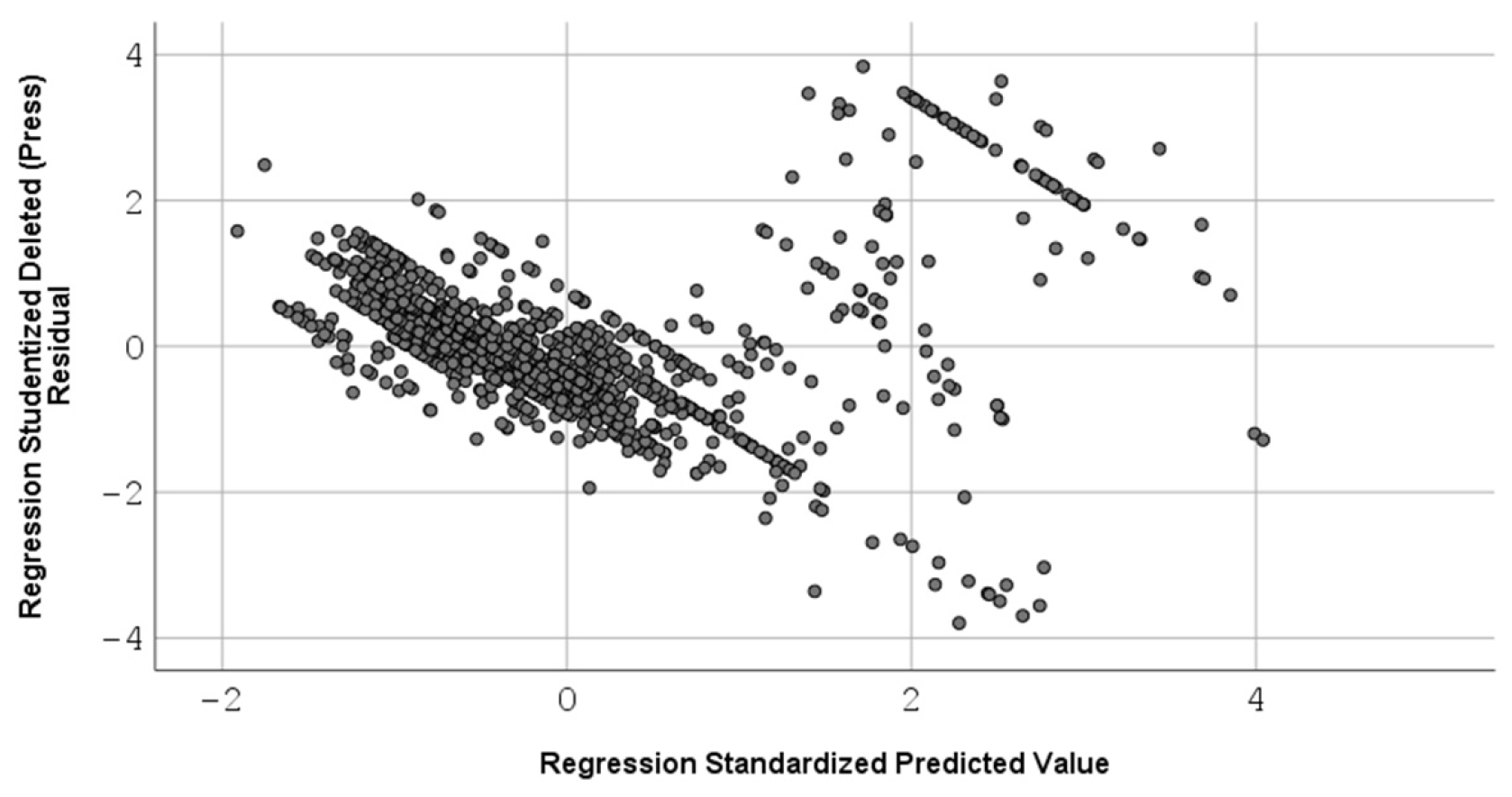1. Introduction
This study is placed in the context of prediction models using either a part of modern Artificial Intelligence (AI), such as ANNs, or more classical statistical predicting methods, such as MLR analysis. This study intends to compare and evaluate the two aforementioned modelling and prediction approaches and intends to provide documented recommendations to WTPs of drinking water operators, concerning which of the two methods should be used, to save time and be as sure as possible of the result and validity of the prediction. The current state of the research field has been reviewed and it is assessed that corresponding comparisons and conclusions have been drawn from a number of other similar studies in the field of catchment hydrology, water quality, groundwater quality, coagulants dosages, lake dissolved oxygen, various species plant growth and missing rainfall data [
1,
2,
3,
4,
5,
6,
7]. ANNs have been used for the prediction of many other environmental variables, including in the water sector, with satisfactory results, such as the prediction of free residual chlorine in water networks, Cr(VI) uptake, reaction cross-sections, Wastewater Treatment Plant (WWTP) effluent water quality [
8,
9,
10,
11], reconstruction of surface water temperature in lakes [
12], Total Dissolved Solids (TDS) [
13], Electrical Conductivity (EC) [
14], and coagulant dosages [
3,
15,
16,
17,
18]. Also, MLR analysis has been used, in a rapid and successful way, to predict surface water quality, flocculants dosages, bromate formation during ozonation, and the formation of disinfection by-products, trophic state of drinking water reservoirs, trihalomethane levels in tap water, and faecal coliform removal [
3,
6,
19,
20,
21,
22,
23]. The ANN model evaluated in this study was previously optimised and takes into account the experience of a WTP operator, based on which the presence or absence of certain input variables was evaluated [
15].
The premier aim and novelty of the current study is the comparison of two prediction methods (ANNs and MLR analysis), with the final goal of helping the WTP of drinking water operators to optimally select the chemical dosages, which are used on a daily basis and is the main daily concern of the operator [
3,
6,
7,
24].
3. Results
Regarding the ANN prediction, the scenario previously chosen (
Figure 3) achieved very good simulation results based on best testing performance indicator (best tperf = 0.008848), which suggests that, in the drinking water sector, ANN modelling is a useful tool for the main operational variable prediction of a treatment plant of drinking water [
15].
For each of the four ANN output parameters, the denormalisation equations [Equations (5)–(8)] of the parameters (where NV is the Normalised Value) are as follows [
15]:
where SP is the Set Point.
Regarding the MLR analysis prediction,
Table 2 shows the values of the multiple determination coefficient,
R2 (coefficient of determination), per scenario studied.
Among the studied scenarios, the best performing one is the one that had Cl
2(g) as a dependent variable. In that case, the value of R
2 = 0.681, which indicates a high correlation as mentioned above (R
2 > 0.5). The same criterion would suggest that the scenario having PACl as a dependent variable was also indicating borderline high correlation (R
2 = 0.501), but given the very high difference with the ANN results (R
2 = 0.742), this is not considered as a good alternative method. For the Cl
2(g) as a dependent variable, using the coefficients of
Table 3, the equation of the MLR mathematical model is given by Equation (9). According to it, the prediction of gas chlorine dosage has a positive relationship with the WTP of drinking water daily electricity consumption, treated water turbidity, water supply, and untreated water turbidity, while it has a negative one with filtration bed inlet water turbidity, treated water residual Aluminium, and PACl dosage (normalised data).
Y: Chlorine dosage (kg/h)
Χ1: Daily consumption of WTP electricity (kWh)
Χ2: Water turbidity in the inlet of filtration beds (NTU)
Χ3: Outlet water turbidity (NTU)
Χ4: Outlet water residual Aluminium (μg/L)
Χ5: Poly- Aluminium Chloride hydroxide sulphate (PACl) (ppm)
Χ6: Outlet water pH
Χ7: Water flow at the entrance of the WTP (m3/d)
Χ8: Untreated water turbidity (NTU)
Table 3.
MLR Analysis Coefficients a.
Table 3.
MLR Analysis Coefficients a.
| Step | Model | Unstandardized Coefficients | Standardised Coefficients | t | Sig. | Collinearity Statistics |
|---|
| B | Std. Error | Beta | Tolerance | VIF |
|---|
| 8 | (Constant) | 0.070 | 0.021 | | 3.284 | 0.01 | 0.01 | |
| | Daily consumption of WTP electricity (kWh) | 0.511 | 0.027 | 0.453 | 18.700 | 0.000 | 0.461 | 2.167 |
| | Water turbidity in the inlet of filtration beds (NTU) | −0.243 | 0.032 | −0.166 | −7.690 | 0.000 | 0.581 | 1.721 |
| | Turbidity of treated water (NTU) | 0.362 | 0.031 | 0.222 | 11.802 | 0.000 | 0.763 | 1.311 |
| | Concentration of treated water Aluminium (μg/L) | −0.202 | 0.022 | −0.178 | −9.064 | 0.000 | 0.699 | 1.430 |
| | Polyaluminum sulphate chloride dosage (ppm) | −0.319 | 0.032 | −0.229 | −10.046 | 0.000 | 0.521 | 1.919 |
| | pH of treated water | −0.141 | 0.021 | −0.161 | −6.864 | 0.000 | 0.495 | 2.021 |
| | Daily supply of untreated water (m3/d) | 0.130 | 0.025 | 0.105 | 5.127 | 0.000 | 0.650 | 1.537 |
| | Turbidity of untreated water (NTU) | 0.305 | 0.085 | 0.069 | 3.582 | 0.000 | 0.729 | 1.371 |
This model (Equation (9)) is statistically significant at a = 0.05 significance level (sig.= 0.000 < 0.05) as we can see from the ANOVA (
Table 4).
All the necessary conditions (e.g., normality, multi-collinearity, homoscedasticity, etc.) are being satisfied in this case. More precisely, the normality of the residuals of the model can be seen in the following histogram (
Figure 4).
Multi-collinearity (i.e., the fact that the independent variables are (pairwise) being linearly related but not strongly is checked using the index Variance Inflation Factor (VIF), or Tolerance. Values of VIF more than 10 and Tolerance less than 0.20 show significant multi-collinearity between the variables. When significant multi-collinearity exists, it should be corrected, but from our analysis results, it is not the case here.
Homoscedasticity (the distribution of the dependent variable must remain the same for each combination of values of the independent variables): we notice the values of the Studentized deleted residuals (
Figure 5), with a few exceptions, lie in the interval [−2, 2] and are almost uniformly (randomly) distributed over the entire range of predicted total values. So, the assumption of homoscedasticity or equality of variances is satisfied.
Regarding the required time for the two modelling approaches, it is worth mentioning that ANN development took a significant amount of time (≈389 min) until the final selection of the optimal network, while the MLR analysis required much less time (a few minutes), working on a laptop Intel Core i5 10th generation processor.
3.1. Root Mean Square Error (RMSE)
Table 5 contains RMSE values for the ANN and MLR analysis prediction models per variable of interest. The physical unit of RMSE is different for each variable: mg/L for O
3, ANPE and PACl dosage, and kg/h for Cl
2(g) flow rate. The parameters R
2 and R are dimensionless quantities.
3.2. Coefficient of Determination (R2)
Table 6 contains the R
2 values for the ANN and MLR analysis prediction models per variable of interest:
The MLR analysis, with the method of stepwise selection of variables (Stepwise method), using SPSS software, was carried out in eight different steps, and in the eighth step the value of R
2 was equal to 0.681, as shown in
Table 2. So, the relationship between the dependent variable of Cl
2(g) dosage and the eight variables is strong and statistically significant (Sig. < 0.05).
3.3. Pearson Correlation Coefficient (R)
Table 7 contains R values for the ANN and MLR analysis prediction models per variable of interest:
4. Discussion
In this comparative study, two models were constructed by using ANNs and MLR analysis in MATLAB and SPSS, respectively, for WTP chemical dosages prediction. The data comes from a 38-month period of monitoring and recording (1188 daily values for each of the 14 variables, total: 16,632 values)
According to RMSE values of predicted and observed values of the ANN and MLR analysis prediction model (
Table 5), the MLR model showed better performance for the three (RMSE ANPE = 0.05 mg/L, RMSE PACl = 0.08 mg/L and RMSE Cl
2(g) = 0.10 kg/h) of the four used WTP of drinking water chemicals, as compared to the ANN model, which was superior for only one of them (RMSE O
3 = 0.02 mg/L). Practically, the value of RMSE is the standard deviation of the prediction errors [
11]. The value of this prediction, using the MLR model, is further enhanced if we consider that the average value of the ANPE dosage is 0.40 mg/L, the PACl dosage is 17.99 mg/L, and the Cl
2(g) dosage is 2.46 kg/h. Additionally, there are studies for the determination of WTP coagulant dosages in which MLR analysis modelling results performed slightly better (small RMSE and high R
2) than ANN modelling [
23]. According to bibliography in prediction modelling, the lower RMSE values and the higher the values of R
2 and R, the closer are the predicted values to the measured values [
2,
6].
Regarding the R
2 values, three of the four examined WTP of drinking water used chemical dosages that were (relatively) satisfactorily predicted by the selected ANN (Cl
2(g) dosage: R
2 = 0.838, ANPE dosage: R
2 = 0.772, PACl dosage: R
2 = 0.742 in descending order), while based on the MLR analysis, it was only one (Cl
2(g) dosage: R
2 = 0.681). The ozone concentration variable showed low values of the R
2, in all cases, possibly due to the large variation in its values. Based on the criterion of R
2 > 0.5, the prediction of the MLR analysis model was evaluated as satisfactory only for the Cl
2(g) dosage (R
2 = 0.681, R = 0.82500). Similar results have also been reported [
1,
3,
6,
7,
28].
We must point out that if someone wants to use the above described (ANN or MLR) scenarios to predict Cl2(g) dosages, it is better to use the one with the smallest RMSE. If they are interested in fitting purposes, it is better to use the one with the largest R2.
According to WTP of drinking water operator experience, the fact that, according to MLR analysis, the prediction of Cl
2(g) dosage has a positive relationship with the daily electricity consumption, treated water turbidity, water flow, and raw water turbidity at the entrance of the WTP, can be explained by the increased burden on the quality of the untreated water, which leads to the increase in the consumption of electricity in the ozonation process and the turbidity of the finally treated water, due to the oxidation of the substances in the last stage of chlorination. In corresponding studies of predicting the WTP flocculants dosages, the designed MLR model presented that coagulant dosage had, respectively, a positive relationship with flow rate, temperature, and turbidity, while it had a negative relationship with pH and alkalinity [
3,
6].
According to Pearson Correlation Coefficient (R), a better prediction is achieved by the ANN model for the three of the four used chemicals (ANPE, PACl, Cl
2(g) dosage), while by the MLR analysis only for one (Cl
2(g)). The results of these metrics are shown for all variables in the respective tables (
Table 6 and
Table 7). The only variable that is clearly indicating a high correlation (R
2 > 0.5) is Cl
2(g) dosage. Compared to the R
2 and R values of the respective ANN results, the ANN outperforms the MLR analysis by 23% and 11%, respectively.
Similar studies of chemical dosages prediction in a WTP of drinking water have shown satisfactory results regarding the performance of the predictions and their high accuracy. Specifically, for chemical dosages predictions using ANNs, the values of the RMSE range from 0.64 to 5.93 mg/L and of R
2 from 0.742 to 0.940. The corresponding values for chemical dosages predictions using MLR analysis are as follows: RMSE ranges from 0.085 to 4.31 mg/L and R
2 ranges 0.63–0.9 [
3,
15,
17,
23,
24,
28].
In conclusion, the three used comparison metrics (RMSE, R
2, and R) show satisfactory results regarding the initial question: which prediction model performs better in predicting the dosages of chemicals used in a WTP of drinking water. The ANN models are much better than the corresponding MLR analysis prediction models, if we are mainly interested in the adaptability of the prediction, while if we are interested in having as few errors as possible in the predicted values, then MLR analysis seems to be better. Generally, ANN models can predict most of the chemicals used in a WTP. However, the prediction performance according to MRL is evaluated as satisfactory, for the case of Cl
2(g). This modelling study using ANNs and MLR analysis is considered very important as the performance of the predictions is satisfactory; the accuracy of the predictions is very high and in this way the prediction of a WTP of drinking water chemical dosages can be conducted by modelling and not by jar tests, which are time-consuming, expensive, and susceptible to human error. Additionally, the modelling results are immediately available, even during rapid and extreme changes in the quality characteristics of the raw water, saving money and human and water resources. Finally, this study further strengthens the opinion that ANN modelling is a useful decision support tool [
15,
29,
30] for a WTP of drinking water operator and can accurate and sufficiently predict the decisions regarding the used chemical dosages that interests them every day.
Future studies are recommended to increase knowledge on the prediction of water chemicals used in a WTP of drinking water by using data-driven models, like ANNs, as an accurate prediction model and MLR analysis, as a flexible and fast but also reliable prediction model. Specifically, in the future, the estimation of the WTP of drinking water-used chemicals dosages, could be studied, using ANNs with only basic variables of the inlet water quality to build faster and more flexible ANN prediction models. Also, even more effort should be made to establish ANNs in the water sector and in the WTPs day-to-day operation [
3,
31,
32]. Future research ideas include exploring the use of other comparison criteria, such as the Mean Absolute Error (MAE), the Mean Absolute Percentage Error (MAPE), or the Nash–Sutcliffe efficiency (NSE), as well as Principal Component Analysis to identify the most influencing parameters. A Sensitivity and Uncertainty Analyses focusing on the most influential parameters could further enhance the modelling process. Finally, given that the main limitation of the current work is that the models have been trained with data from a single WTP of drinking water, we suggest as future work, the inclusion of data for more WTPs of drinking water, in order to increase the robustness of the models and their universal applicability.












